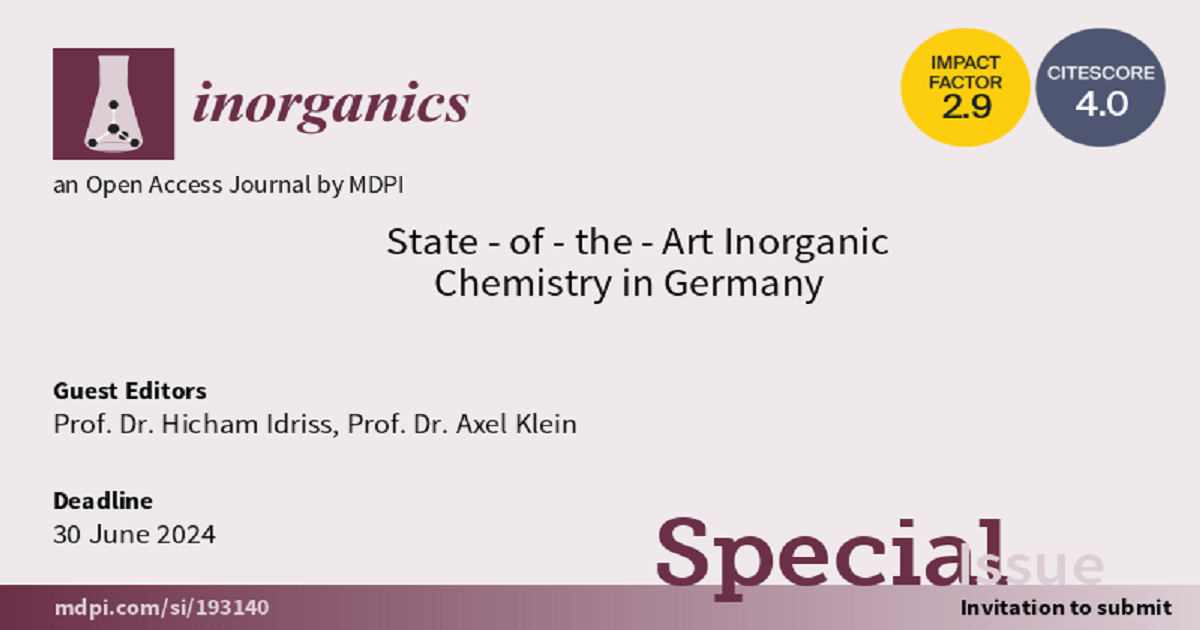State-of-the-Art Inorganic Chemistry in Germany
A special issue of Inorganics (ISSN 2304-6740).
Deadline for manuscript submissions: 30 June 2024 | Viewed by 203

Special Issue Editors
Interests: catalysis; hydrogen production/water splitting; electron transfer; surface reactions; reducible oxides
Special Issues, Collections and Topics in MDPI journals
Interests: transition metal complexes (including organometallic); platinum, palladium, nickel; synthesis; electrochemistry; photophysics; spectroscopy; modelling of catalytic processes
Special Issues, Collections and Topics in MDPI journals
Special Issue Information
Dear Colleagues,
This regional Special Issue focuses on the frontiers of inorganic chemistry in Germany. Colleagues are invited to submit original articles, communications, and critical reviews. We welcome submissions that are within the scope of inorganic chemistry research.
Topics include but are not limited to the following research areas:
- Coordination chemistry;
- Organometallic chemistry;
- Bioinorganic chemistry;
- Solid-state chemistry;
- Inorganic materials;
- MOFs (metal–organic frameworks);
- Energy;
- Catalysis (including photo- and electro-catalysis).
Prof. Dr. Hicham Idriss
Prof. Dr. Axel Klein
Guest Editors
Manuscript Submission Information
Manuscripts should be submitted online at www.mdpi.com by registering and logging in to this website. Once you are registered, click here to go to the submission form. Manuscripts can be submitted until the deadline. All submissions that pass pre-check are peer-reviewed. Accepted papers will be published continuously in the journal (as soon as accepted) and will be listed together on the special issue website. Research articles, review articles as well as short communications are invited. For planned papers, a title and short abstract (about 100 words) can be sent to the Editorial Office for announcement on this website.
Submitted manuscripts should not have been published previously, nor be under consideration for publication elsewhere (except conference proceedings papers). All manuscripts are thoroughly refereed through a single-blind peer-review process. A guide for authors and other relevant information for submission of manuscripts is available on the Instructions for Authors page. Inorganics is an international peer-reviewed open access monthly journal published by MDPI.
Please visit the Instructions for Authors page before submitting a manuscript. The Article Processing Charge (APC) for publication in this open access journal is 2700 CHF (Swiss Francs). Submitted papers should be well formatted and use good English. Authors may use MDPI's English editing service prior to publication or during author revisions.
Keywords
- synthesis
- structure
- reactivity
- activity
- chemical properties
- physical properties
- applications
- inorganic compounds
- inorganic complexes
- inorganic materials
Planned Papers
The below list represents only planned manuscripts. Some of these manuscripts have not been received by the Editorial Office yet. Papers submitted to MDPI journals are subject to peer-review.
Title: Baden Blue: A Formate Analogue of Prussian Blue
Authors: Martin Viertelhaus, Jonas Braun, Sharali Malik, Christopher E. Anson, Annie K. Powell
Affiliation: Karlsruhe Institute of Technology (KIT)
Abstract: We report the solvothermal synthesis and crystal structure of [MgII(H2O)6][FeIII2{FeIIxMgII1-x}2(O2CH)12]·3HCO2H. The dark blue compound crystallises with a cubic lattice in which trivalent iron ions alternate with divalent iron or magnesium ions in a similar fashion to Prussian Blue. Rather than having cyano bridges the metal ions are connected by formate bridges. This creates an intervalent system as shown by the magnetic and spectroscopic data.
Title: Synthesis of tris(trifluoromethyl)nickelates(II) – Coping with the C2F5 problem
Authors: S. A. Schäfer, R. Jordan, F. Herwede, A. Klein*
Affiliation: Department für Chemie, Institut für Anorganische Chemie, Universität zu Köln, Greinstraße 6, 50939 Köln, Germany






